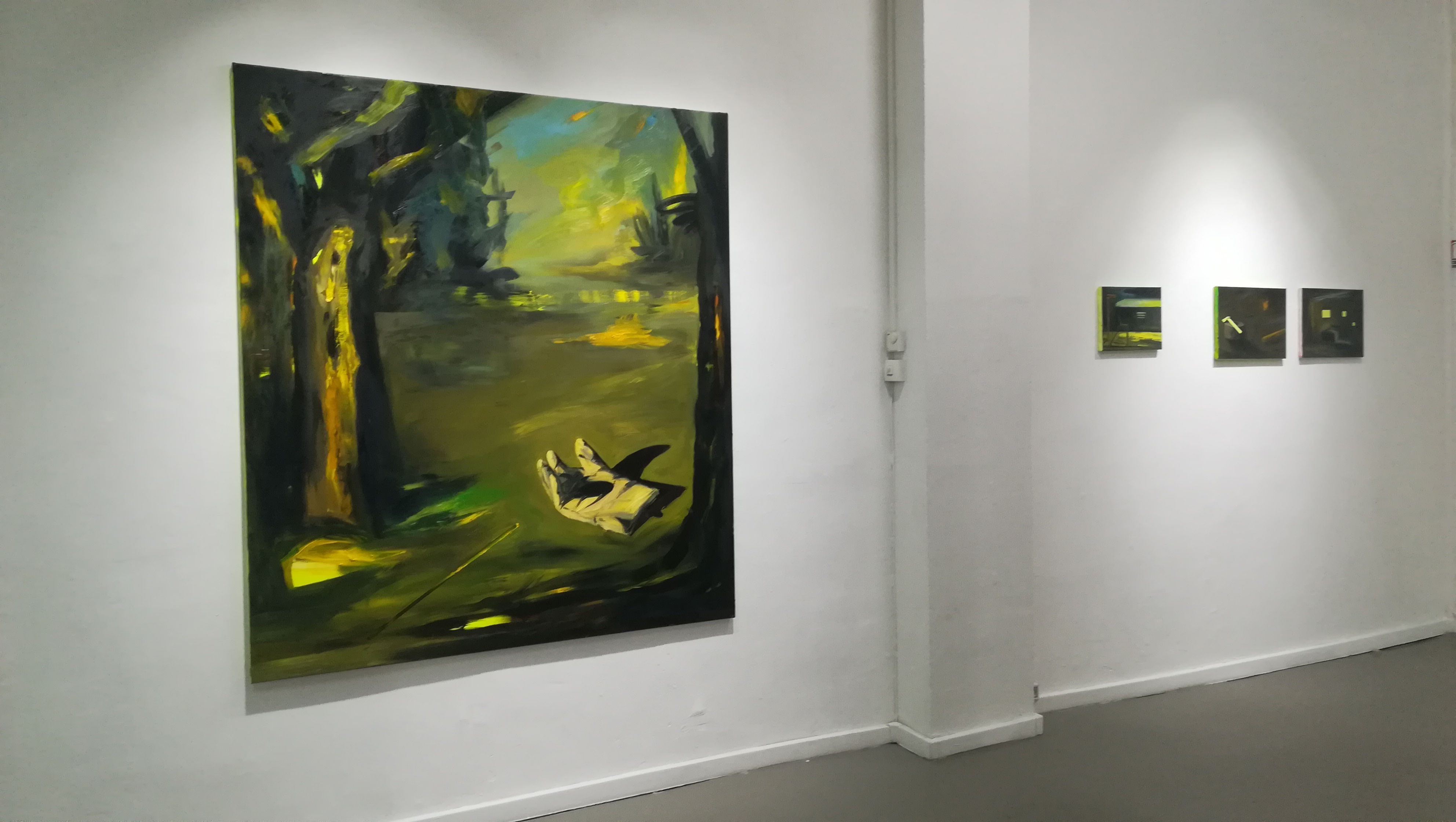



Press release
Text by Théo-Mario Coppola
Karine Hoffman lives and works in Paris. Rare figure in European painting, she develops her work through traces of ghost memory. For her first exhibition at galerie dix9, a group of recent paintings is presented, each piece constructed as an impossible equation, referring to forgotten places or lives, from Lodz to Vilnius. Karine Hoffman defines her own painting as a filter that reveals what has fallen into oblivion, a place distant to herself where narrative fragments and personal obsessions arise ... painting as a world and as a place for a perpetual quest where action is relayed at the margin, giving way to phantasmagoria and play.
Investigation
Contradictions animate Karine Hoffman painting process. Each paradox echoes existentialist philosophy, carried by the breath of a dark empiricism: flesh without shadow is a corpse without desire. Inaccuracies sign the possible construction of a story, as they leave ample margins in the hollow of which flow fantasies, jokes, puns, grotesque ideas. Karine Hoffman proceeds by investigations; research built by experience and inaccuracies, by accumulation of ideas and situations. Each painting is part of a journey, a step in this global investigation. Each title marks a certain confusion between languages, the impossibility of translation, the emotional dimension of words. Painting preserves its primordial ontology; the hidden meaning is the crucial element to define it. Not the necessary revelation or forced explanation.
Split in the East
Before knowing Poland, Karine Hoffman has delivered a romanticized vision of it by using scattered elements. Scenes with no main action, suspended in an uncertain time, carry objects and words. Each of these elements are indications of an investigation of both her personal destiny and the past of Poland. To Karine Hoffman, painting is the possible split of the individual; by creating a fiction of another herself, living the oddness of painting, the all-powerfulness of sensation. By existing in a different way in her paintings, she creates a distance between herself and her own story. Painting allows her to live a second time, as in an invention or a dream. This personal methodology assets painting is a work of lies and secrecy. She proceeds in the same way on her return from Vilnius, with a series of works that reinterprets a journey that has become a fantasy.
World-landscapes
Horizons obstructed by the presence of a wall, impossible breakthrough to the light, deep smoke disturbing the vision. Anything that restricts the view increases the complexity of the landscape. Encrypted, inclusive, secret, kabalistic, Karine Hoffman's world-landscapes contain alchemical processes. The translation from one world to another, from one landscape to another, from one state to another, announces a moment of change. The representation must not be truthful or authentic. On the contrary, each painting is an autonomous world, made up of fantasies and aporia. With the KOSMOS series, the horizon seems to open up, but it is mainly to stretch the distance and multiply pictorial gestures and textures, the effects of matter by which certain details of the works tend to an occult abstraction.
What we owe to Witold Gombrowicz
Witold Gombrowicz is a key author to seize Karine Hoffman?s work. Like him, she rejects the idea of purity, the very idea that can exist a floating and intact state of thoughts, totally detached from reality. On the contrary, contamination of terms, perpetual disruption and sacred moribund enigmas reign together. The form is unceasingly the same and constantly strange is unprecedented. A contradiction which is the only possible expression of our condition. A polymorphic obsession, certain, inexorable. Neither modern nor traditional, Cosmos is a singular work that defies the avant-gardes as the defenders of a return to classicism. It escapes categorization. The lively and withdrawn style brutalizes the understanding, causing an acceleration of the understanding of the very real. The scenes are written with a vigor that oscillates between extravagant scenery and demonic symbolism, between the search for a state and the impossible prescience of the real.
Literary resonances
Karine Hoffman's work is crossed by a literary narrative tradition, a textual mental space in which we meet Franz Kafka, Bruno Schulz, Jorge Luis Borges and Philip. K. Dick and Witold Gombrowicz. Each one of them follows a writing by investigations without solutions, pursuing unfinished quests, constructing stories that jostle one another in dead ends. The impossible is not a complication but a method of work, a way of constructing a reflection on the world. Answering an interrogation by another interrogation continually prolongs the energy of questioning. The present exists only to the extent that it retains a set of enigmas, a series of clues.
History, territory of the abyss
The scenes seem to escape the characterization of the place: absence of architectural elements and cartographic landmark. The indices of time can capture part of the investigation. The titles (in relation to clues and anecdotes) activate this unconventional narration, breaking with the chronology or the veracity of the facts. A worn-out glove, a luminescent tree, a murderous ice ax, a bent palisade are imposed in index of an enigma, a territory of the abyss. While in previous series, the object remained related to the human measure and was still a simple tool, the series Kosmos demonstrates the excess, the distortion, the delusional presence of it. The objects shape the inner dramaturgy. The world submerges space, ruling out the possible human presence. It is no longer an abandoned action, the scene without the presence of its actors who dominate, but the strange embrace of objects. These scenes are the continuation of a dream, a torment, a trauma: they mark the impossible quietness of personal destinies traversed by history.











